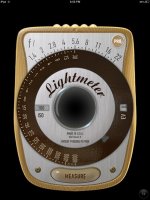Johnhw
Established
Don;t know if this should go here but i'll give it a shot as my Fuji x pro is my main camera.
I am considering getting a Sekonic light meter (the 758DR). I think this will save me time mainly with long exposure type photography which I seem to be getting into more and more, as well as general purpose stuff.
I am wondering if any of you still use light meters, and if you have found it to be valuable at times for exposure vs. the cameras metering and exposure compensation.
Please give me your thoughts. I have been hedging on this for a long time, don;t use flash all that often, though I probably should more (I have a EF20) and overall wonder if anyone finds a drastic change in using a meter or viewing screen shots and histogram for corrections,
Thanks...
I am considering getting a Sekonic light meter (the 758DR). I think this will save me time mainly with long exposure type photography which I seem to be getting into more and more, as well as general purpose stuff.
I am wondering if any of you still use light meters, and if you have found it to be valuable at times for exposure vs. the cameras metering and exposure compensation.
Please give me your thoughts. I have been hedging on this for a long time, don;t use flash all that often, though I probably should more (I have a EF20) and overall wonder if anyone finds a drastic change in using a meter or viewing screen shots and histogram for corrections,
Thanks...



